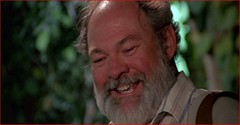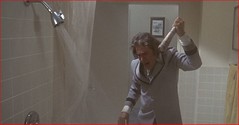
Note: This is the second of my two posts for Edward Copeland's Star Wars Blog-a-thon
I'm sure I wasn't the only one who fantasized about seeing the numerals I-VI gracing DVD spines along my shelf someday. It would finally be complete: a full Star Wars saga along my DVD shelf, just waiting for me to watch in sequence over the course of a weekend. Even though I have owned these six DVDs for quite awhile now, this post is how last week I rearranged them for good -- because I will never watch them in the intended order again. Acting on a tip I read on some forgotten message board last year, I discovered the Star Wars configuration that allows for maximum enjoyment:
1. Episode IV: A New Hope
2. Episode V: The Empire Strikes Back
3. Episode I: The Phantom Menace
4. Episode II: Attack of the Clones
5. Episode III: Revenge of the Sith
6. Episode VI: Return of the Jedi
When viewing Star Wars in the intended order, one thing you will notice is how much the drama in IV-VI is diminished from the knowledge you gain from I-III: "I am your father" (yes, we know!), "there is another" (one movie too late!) and "I'm Luke Skywalker, I'm here to rescue you" (and get out of that alluring pose -- you're my sister!). Vader's confession in Cloud City is one of the series' defining moments, and when you already know the for some time it loses most of its dramatic effect, because the revelation only involves Luke, and not the audience. By knowing of Leia's identity, there is an asterisk placed next to most of her and Luke's interactions, because we know that there is no way they could possibly have a real relationship. In the new configuration, there is genuine tension within the Luke-Leia-Han love triangle because we're not sure who to root for and who they would be best suited for. After watching I-III you know right off the bat that Han is the one for Leia because really -- he's the only one. Yoda is also a character who suffers when the saga is viewed in its intended order: one of the greatest parts of Empire is Luke's interaction with this strange goblin-like creature, and the revelation of how powerful he is as a Jedi. After seeing his battles against Count Dooku and Darth Sidious, you find yourself wondering when he's going to break out all his acrobatics, instead of "this guy, a Jedi?"
So with A New Hope and Empire right up front those movies retain all their emotional and dramatic impact, but they also give quite a boost to the prequels. As the first episode, The Phantom Menace is a terrible way to begin a monumental sci-fi opera -- the movie itself has little urgency, and it contains scant clues that it is the precursor to five more movies. If you watched The Phantom Menace without seeing any of the other installments, would you really believe that it spawned five wildly popular and influential sequels? Despite Palpatine's presence, Darth Maul is movie's main villain, and he obviously dies. You really have to strain to catch that Anakin has any evil in his body, much less the capacity to become the galaxy's greatest monster. But when you view it after seeing IV and V, you already know Anakin's future and that forces you to pay more attention to an otherwise unremarkable character. You also know about Obi-Wan and the huge role he plays in Luke's development and the fact that somewhere along the line he and Anakin had a bad break up. This knowledge lends more meaning and urgency to The Phantom Menace.
This fact carries over to Attack of the Clones, as we see Obi-Wan and Anakin's relationship filled with tension but hardly murderous motivation. The knowledge that Anakin will eventually become apparently grossly disfigured and join the Dark Side also forces you to pay a closer eye to the character, as well as Palpatine. Episode III exists well on its own, but it becomes more grim when you know just how encompassing and oppressive the Empire will be in the future, and how ignorant politics played a role in it.
Return of the Jedi is obviously a rightful final chapter to the saga, but viewing it right after Episode III enhances it greatly. For one thing, Jedi as a movie is more closely related to the prequels as it is to the original trilogy. The final installment feels little like the purposeful concisely-plotted movies that originally preceded it, rather it has the grand scale and big budget feel of the contemporary installments. A New Hope and Empire carry a lot of weight because of all the story they bring to the table -- Jedi is a crowd pleaser, but it's also pretty much about one singular event save for the opening sequence. Like the CGI heavy prequels, Jedi earns its stripes by expertly putting the audience in the middle of an epic war for survival -- which distracts you from its minuscule story. But Jedi gains a legitimate emotional boost from the events in Episode III, namely the interactions between Anakin and Palpatine.
This enhancement occurs even when the saga is shown in the original sequence, but the connections are more focused when VI follows III. With knowledge of the Sith in hand, we as viewers know that the Emperor's true motivation for Luke is to have him slay his father, which in one swoop of a light saber will push him over to the Dark Side and allow him to be the Emperor's new protege. As we learned in Episode I and saw first-hand with Palpatine and Count Dooku in Episode III, there can only be two Sith Lords at a time -- a master and a protege. Palpatine needed Dooku out of the way to make room for the more powerful Anakin, and in Jedi we find Vader nearing the end of his line. The master/protege concept adds another layer of intrigue to the events at the end of Jedi, because Vader stated in Empire that he and Luke could "rule this galaxy as father and son," which now takes on the meaning of Vader or Luke slaying the Emperor. The fact that Ian McDiarmid was able to reprise his role in the prequels is a major asset for the whole saga, because it allows a near seamless bridge between III and Jedi.
But what narrative explanation is there for the series suddenly shifting backwards 20 years after Empire? One explanation is that the prequels exist in Vader's subconscious, after his failed overture to Luke he takes a rare inward glance to when he resembled his son. Vader appears more civilized and familial toward Luke in Jedi, and the idea that he recently traced his own footsteps to how he became Darth Vader may make it easier to explain why he suddenly grew a heart. Even after Anakin's warpath in Episode III, you never get the sense that he has truly become the evil, iron fist Darth Vader of the original series -- time has obviously shaped him since his Mr. Roboto turn, and his actions at the end of Jedi may show that he has remembered his true persona.
It's obviously a stretch to explain the new configuration narratively, but it is undoubtedly more entertaining to view them out of sequence. There's obviously a few other configurations for the saga -- its theatrical chronology seems like an easy choice -- but it would be difficult to really justify another radical sequence like this one because Episodes I-III really need to be seen consecutively. The prequels really do have a huge story arc, and when viewed out of sequence they become less meaningful. For me, I've altered the order of my DVD shelf and that's how it's staying.
Thursday, May 24, 2007
Reconfiguring the saga
Filed Under Blog-a-thon
Subscribe to:
Post Comments (Atom)












3 comments:
WOW! I love this idea, and the order you've chosen is truly inspired. As I discussed in my SW Blog-a-Thon entry, I've watched the original now with my son for the first time, and as we move on I think I'll definitely use the order you're suggesting.
I think that the jump from Empire to Phantom makes total narrative sense, especially the way you've described it. It's a classic movie storytelling trick (as well as in novels, for that matter) for an extended flashback to follow a high-energy narrative cliffhanger - such as Vader's revelation to Luke at the end of Empire. It gives the story time to breathe again, and allows us to contemplate the main story's implications as we learn what has brought us up to this point.
And then, by the time you pick up VI, the story's heavy lifting is complete and all that's left is to connect the dots and stage the final confrontation between Vader and Luke. Terrific!
Most excellent! The next time I've got a day to kill, this is how I'll spend it. (Well, assuming there's no yard work bearing down on me.) I've looked for a way to tie the two trilogies together that minimizes their differences, and I think this is a great approach. Cheers!
I toggle back and forth between watching the films in order of production and in SWU-chronology. Anyone watching for the first time should not be given a choice. You have to watch IV-VI then I-III. You've pinpointed the worst violations, all the surprises ruined. That is, for me, the biggest problem with the NEW HOPE Special Edition. Who-shot-who in what cantina is not really so big a deal as destroying the carefully built-up entrance of one Jabba the Hutt. There are a lot of grace notes you can locate by watching the films in nearly any order, but just as many undone or destroyed.
Post a Comment